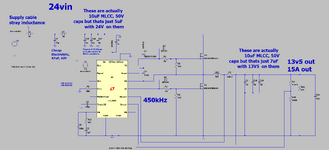cupoftea
Advanced Member level 5
Hi,
We are doing a Buck with Vin=24-32V, VOUT=13V5 AND iOUT = 15A at 450kHz.
From the LTspice simulation attached, it shows that the tiny input filter of just three 10uF,50V MLCCs and one 1uH inductor has pretty much filtered out all of the switching ripple!
Supposing this converter then failed conducted EMC, then do you agree that the problem must be common mode, because the diff mode filtration simply has filtered
out pretty much all of the diff mode disturbance?
If this converter failed conducted EMC, would you be sure that it was a common mode problem?
The close up waveform of the input current shows a smooth 450kHz sinewave of some 120mApkpk....such a waveform is far too smooth to fail
any EMC test?
We are doing a Buck with Vin=24-32V, VOUT=13V5 AND iOUT = 15A at 450kHz.
From the LTspice simulation attached, it shows that the tiny input filter of just three 10uF,50V MLCCs and one 1uH inductor has pretty much filtered out all of the switching ripple!
Supposing this converter then failed conducted EMC, then do you agree that the problem must be common mode, because the diff mode filtration simply has filtered
out pretty much all of the diff mode disturbance?
If this converter failed conducted EMC, would you be sure that it was a common mode problem?
The close up waveform of the input current shows a smooth 450kHz sinewave of some 120mApkpk....such a waveform is far too smooth to fail
any EMC test?
Attachments
Last edited:


